VISITING THE SMOKY MOUNTAINS IN FALL
Learn what to expect when visiting Great Smoky Mountains National Park in the Fall
The fall colors of Great Smoky Mountains National Park put on a spectacular show similar to New England. These maple, oak, and hickories display colors that will blow your mind. And, there are so many things to do in the fall that showcase the changing colors. Visiting in the fall has many benefits, as well as some drawbacks. Below, we will go into detail about what to expect in the fall, and how to best plan for your trip. No matter what you decide to do during your trip, you will no doubt leave with an appreciation of the force of nature and experience the joy of fall in the Smokies.
For a prediction of when the leaves will peak in their color, take a look a the Fall Foliage Prediction Map.
BENEFITS OF VISITING GREAT SMOKY MOUNTAINS IN FALL
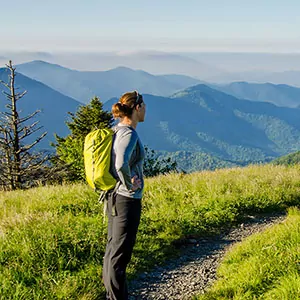 Over 100 species of trees live in the Great Smoky Mountains, and most of them are deciduous, so the fall colors they display are absolutely fantastic. This is the major benefit of visiting the park in the fall; the changing colors rival those of New England. In addition to the orange, yellow and red trees, there are magnificent wildflowers that bloom in the park year-round.
Over 100 species of trees live in the Great Smoky Mountains, and most of them are deciduous, so the fall colors they display are absolutely fantastic. This is the major benefit of visiting the park in the fall; the changing colors rival those of New England. In addition to the orange, yellow and red trees, there are magnificent wildflowers that bloom in the park year-round.
Another benefit to visiting the Great Smoky Mountains in the fall is the weather. It is typically the driest season of the year, and the weather is near-perfect with warm temperatures during the day and cooler temperatures in the evenings. With the weather so nice, there are an abundance of activities you can enjoy. Take a look at the National Park Service’s list of autumn drives and hikes for recommendations in the less crowded areas of the park.
DRAWBACKS OF VISITING GREAT SMOKY MOUNTAINS IN FALL
 The only drawback to visiting in the fall is the crowds. The fall colors show attracts many visitors, especially during the last three weeks of October, making it one of the busiest months to visit the Great Smoky Mountains. The most congested areas are Cades Cove and Newfound Gap, but there are many other places to visit that will seem calmer and may provide a chance for solitude—these areas include: Oconaluftee, Cataloochee, Balsam Mountain, and Deep Creek.
The only drawback to visiting in the fall is the crowds. The fall colors show attracts many visitors, especially during the last three weeks of October, making it one of the busiest months to visit the Great Smoky Mountains. The most congested areas are Cades Cove and Newfound Gap, but there are many other places to visit that will seem calmer and may provide a chance for solitude—these areas include: Oconaluftee, Cataloochee, Balsam Mountain, and Deep Creek.
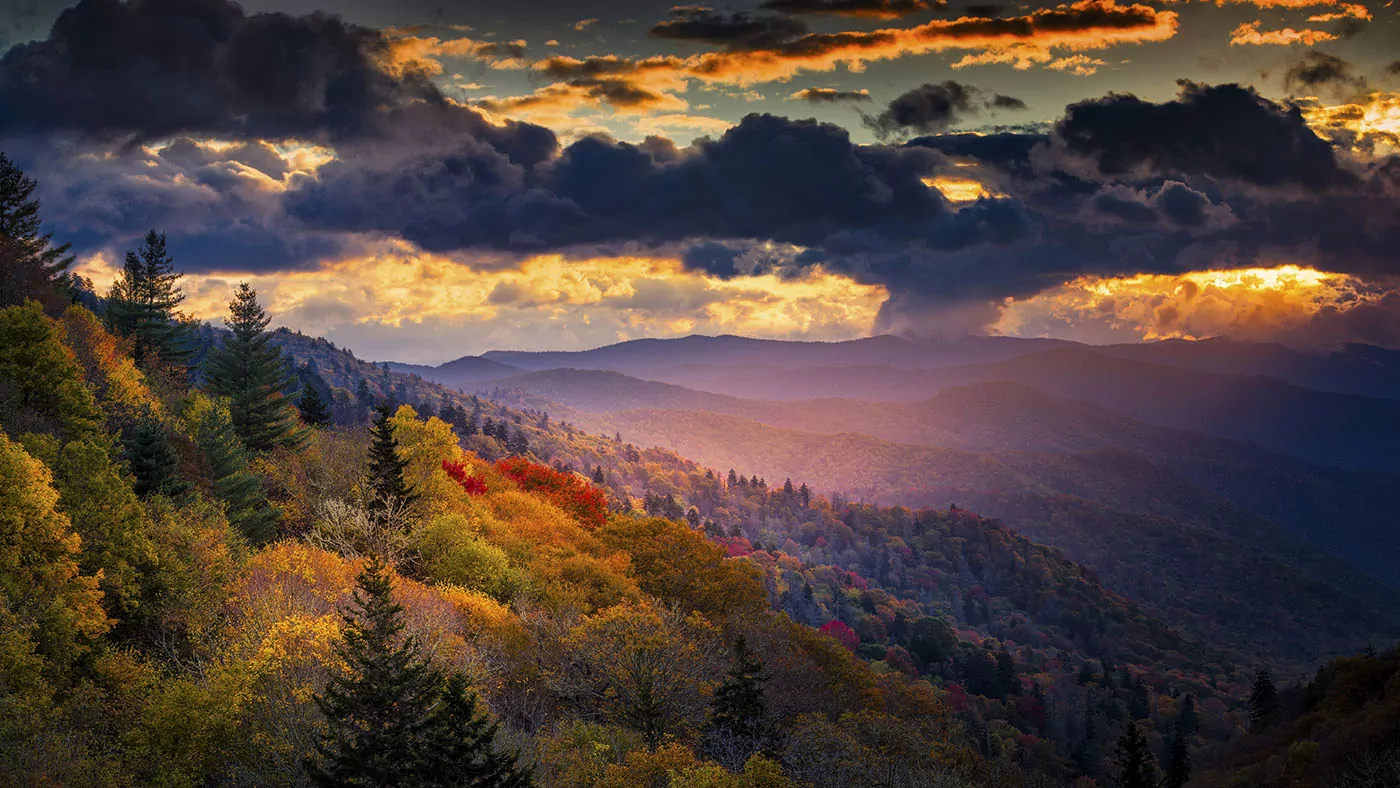
THINGS TO DO IN FALL
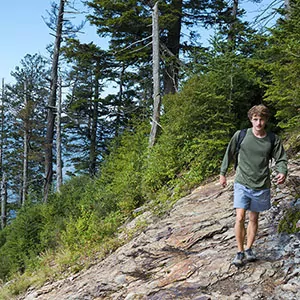
Each season brings new and exciting things to do in the Smokies. The most popular things to do in the fall include:
Hiking: The weather and colors of fall make this the perfect time of year for hiking. There is an abundance of trails that will lead you through meadows of ever-changing fall-colored deciduous trees. Eighty percent of the trees in the Great Smoky Mountains National Park are deciduous; these maples, hickories, and beech trees transform into vibrant reds, oranges, and yellows, giving you world-class scenery as you hike. Check out the Park Service’s list of best fall trails for suggestions.
Backpacking: If you want to be immersed in the colors of fall, with little-to-no people, for an extended amount of time, backpacking in fall is the best thing for you! There are so many trails and backcountry campsites to string together into a multi-day trip. You can also book a guided backpacking adventure at any time of the year. Backpacking in the fall is something you don’t want to miss out on!
Fall Foliage Sightseeing: The best thing about Fall in the Smokies is the color-changing trees. Eighty percent of the park is deciduous trees, so they put on quite a show in the autumn. The elevation drastically affects when colors start changing; at high elevations, the yellow birch, American beech, and mountain maple begin to change colors in mid-September. And, at elevations of 4,000 feet and above, the colors begin to change in early to mid-October—the best views of these colors are from Clingmans Dome Road, Foothills Parkway, or Blue Ridge Parkway. The peak season for fall colors at mid to lower elevations is late October and November, the sugar maple, scarlet oak, sweetgum, and red oak are a magnificent sight this time of year.
Wildlife Viewing: Most seasons are great for wildlife viewing, but the fall is particularly extraordinary. The fall is the breeding season for elk, known as “the rut”; large male elk (called bulls) can be seen with their harem of up to 20 female elk (called cows). Bull elk display large antler racks and proud strut about to intimidate other bulls. Cataloochee is the best place in the park to observe the elk rut.
Fishing: Fall is a great time to fish in Great Smoky Mountains National Park, as the weather begins to cool, the biting insects are gone, and the trees are a rainbow of colors. Read all about fall fly fishing in the Smokies here.
Bicycling: Riding through the park is ideal in the fall. Traffic is still quite heavy in October, but if you get out early enough, you can have the Cades Cove loop to yourself for the beginning of your ride. Cades Cove is a great place to watch the fall colors in October and November and a great place to spot wildlife year-round.
HIKING IN FALL
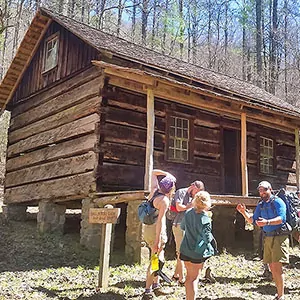 Fall hiking is ideal in the Smokies; there are many trails that will take you to incredible overlooks and through tunnels of ever-changing leaves. The various elevations in the park change colors at different points in the season, so there are some hikes that are better in early fall and others that are better in late fall. We have broken down the best hikes in the fall, based on the elevation of the trail and when the leaves will be in their peak color.
Fall hiking is ideal in the Smokies; there are many trails that will take you to incredible overlooks and through tunnels of ever-changing leaves. The various elevations in the park change colors at different points in the season, so there are some hikes that are better in early fall and others that are better in late fall. We have broken down the best hikes in the fall, based on the elevation of the trail and when the leaves will be in their peak color.
The best hikes in mid to late September are:
- Andrews Bald: Start at Clingmans Dome, and hike 1.7 miles to an outstanding overlook. From the top of the bald, you have panoramic views for as far as the eye can see. The trail is easy to moderate with an elevation gain of 514 feet.
- Mount LeConte: Start at the Alum Cave trailhead on Newfound Gap Road, and hike 5.5 miles to Cliff Top, where you will receive expansive views of warm-colored trees for miles and miles. The trail is strenuous with an elevation gain of 2763 feet.
- The Jump-Off: Start at the trailhead on Newfound Gap Road, and hike 3.2 miles; where you will be rewarded with fantastic views along the trail. From the vantage point of the Jump-Off, you will have incredible views of Mount LeConte, Charlies Bunion, and the Appalachian Trail. The trail is moderate with an elevation gain of 1725 feet.
In early to mid-October, the best hikes are:
- Gregory Bald: Start from the Gregory Ridge Trailhead in Cades Cove, and hike 5.7 miles to an outstanding vista. On a clear day, you will be able to see Cades Cove, Thunderhead Mountain, Clingmans Dome, and Fontana Lake. The trail is strenuous with an elevation gain of 3020 feet.
- Albright Grove: Start at the Maddron Bald Trailhead, and hike for 3.3 miles to the grove. Albright Grove is home to one the largest hardwood forests in the world, with some of the oldest and largest trees in the park. Red maples, American beech, yellow birch, buckeyes, and sugar maples abound. This is a moderate trail with an elevation gain of 1475 feet.
- Spence Field: Start at the Anthony Creek Trailhead at the Cades Cove picnic area, and hike 5.2 miles to an amazing vista of the North Carolina side of the Smokies. The trail is strenuous with an elevation gain of 2842 feet.
In mid to late October, the best hikes are:
- Shuckshack Fire Tower: Start at the trailhead, located in the southern corner of the park, near Fontana Dam. You will hike on the Appalachian Trail until you reach the junction for the fire tower. After you climb 78 steps to the top, you will receive expansive views of the Blue Ridge Mountains, the Smoky Mountains, and the Nantahala Mountains. This trail is moderate to strenuous with an elevation gain of 2120 feet.
- Charlies Bunion: Start at the trailhead on Newfound Gap Road, and hike 4 miles to the popular rock outcropping. Throughout the entire hike, you will be treated to stunning views of the North Carolina Smokies. This trail is moderate to strenuous with an elevation gain of 1640 feet.
- Grapeyard Ridge Trail: Start at the trailhead in Greenbrier, and hike for 2.8 miles through the dense and colorful forest. This trail is moderate with an elevation gain of 980 feet.
And, in early November, the best hikes are:
- Abrams Falls: Start at the Abrams Falls Trailhead in Cades Cove, and hike for 2.6 miles through a rhododendron and hemlock forest to Abrams Falls—a short and squat waterfall; only 20 feet tall, but the large amount of water that pours over its’ side makes up for the lack of height. This trail is easy to moderate with an elevation gain of 675 feet.
- Oconaluftee River Trail: Start at the trailhead just behind the Oconaluftee Visitor Center, and take the 3-mile loop trail. The trail winds next to the river, through forests of eastern hemlock, sugar maple, yellow birch, and basswood, creating a rainbow of colored leaves. The trail is easy with an elevation gain of 70 feet.
- Deep Creek Trail: Start at the trailhead, just north of Bryson City, North Carolina, and hike for 2.3 miles through a thick forest. The low elevation of Deep Creek makes for perfect hiking in November when the fall colors have reached the lowest points in the park. This trail is moderate to easy with an elevation gain of 579 feet.
Check out the best fall hikes in the Smokies for a comprehensive list.
Another great option for hiking in the fall is to join a guided day hike—where you will trek through incredible landscapes while gaining insight into the natural and cultural history of the region. With local and professional guides, and the appropriate gear provided, you are given a comprehensive experience of the Smokies.
BACKPACKING IN FALL
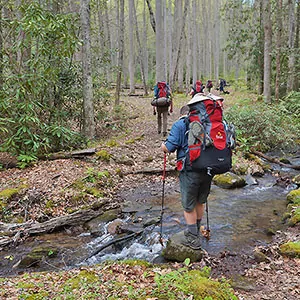 Backpacking is absolutely breathtaking in the fall in the Great Smoky Mountains. On a multi-day trip, you are able to get high to elevations where you can overlook the extraordinary colors of the mountainsides and ridgelines. The fall colors transform the trees at higher elevations, where the climate is similar to New England, first. The best time to go backpacking in the fall is in early to mid-October when the fall colors are peaking at elevations above 4,500 feet. You can read all about how to obtain backpacking permits in the Great Smoky Mountains and look at the backcountry trails map to help plan your adventure.
Backpacking is absolutely breathtaking in the fall in the Great Smoky Mountains. On a multi-day trip, you are able to get high to elevations where you can overlook the extraordinary colors of the mountainsides and ridgelines. The fall colors transform the trees at higher elevations, where the climate is similar to New England, first. The best time to go backpacking in the fall is in early to mid-October when the fall colors are peaking at elevations above 4,500 feet. You can read all about how to obtain backpacking permits in the Great Smoky Mountains and look at the backcountry trails map to help plan your adventure.
A great option in the fall is a guided backpacking trip, where the company provides a knowledgeable and professional guide, top-notch gear, and gourmet backcountry meals. Wildland Trekking also offers inn-based trips to Mount LeConte, in which you will hike to the top, and spend your nights at the historic and rustic LeConte Lodge overlooking the mountains.
WEATHER AND TEMPERATURES IN FALL
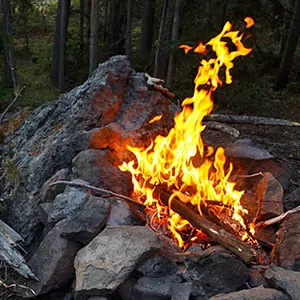 The weather varies drastically from the base of a mountain to its top, as well as from September to November. Temperatures during the day in September can be in the 70s and 80s, and drop into the 50s at night. As the season progresses into November, you could experience the 50s and 60s during the day, with nighttime temperatures dipping toward freezing. Fall is typically the season with the least amount of precipitation, although the first snowfall could come as early as November in the mountains.
The weather varies drastically from the base of a mountain to its top, as well as from September to November. Temperatures during the day in September can be in the 70s and 80s, and drop into the 50s at night. As the season progresses into November, you could experience the 50s and 60s during the day, with nighttime temperatures dipping toward freezing. Fall is typically the season with the least amount of precipitation, although the first snowfall could come as early as November in the mountains.
Make sure you bring layers of warm clothing and rain gear, because the weather and temperature can change without warning, and you don’t want to get caught on the top of a mountain without the appropriate gear. Also, be prepared for a hike with 3 liters of water—even though the temperature may be cooler, and you may not be sweating, you can still get dehydrated.
Below is the typical temperature and days of precipitation for September, October, and November in the Smokies, for Sugarlands Visitor Center and Clingmans Dome:
| Month | Sugarlands Visitor Center | Clingmans Dome | Days of Precip | ||
| Avg Hi | Avg Lo | Avg Hi | Avg Lo | ||
| September | 80°F (26°C) | 56°F (13°C) | 60°F (15°C) | 47°F (8°C) | 7-8 Days |
| October | 71°F (21°C) | 44°F (6°C) | 71°F (21°C) | 39°F (3°C) | 6-8 Days |
| November | 61°F (16°C) | 35°F (1°C) | 42°F (5°C) | 28°F (-3°C) | 7-9 Days |
JOIN A GUIDED HIKING ADVENTURE
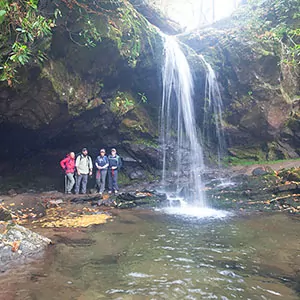 Great Smoky Mountains National Park is a rich, pristine wilderness with abundant wildlife, amazing views, and unforgettable opportunities for hiking vacations. Wildland Trekking offers a variety of ways to enjoy the Smoky Mountains, including backpacking trips, portered treks, inn-based tours, and day hikes.
Great Smoky Mountains National Park is a rich, pristine wilderness with abundant wildlife, amazing views, and unforgettable opportunities for hiking vacations. Wildland Trekking offers a variety of ways to enjoy the Smoky Mountains, including backpacking trips, portered treks, inn-based tours, and day hikes.
Guided Smoky Mountain treks are all-inclusive meaning the following is included: local round-trip transportation from Asheville; wonderful meals; top-of-the-line equipment; risk management systems; professional hiking/wilderness guides and more.
SMOKIES ADVENTURE TOURS
- GUIDED BACKPACKING TRIPS: these adventures are opportunities to explore the deep wilderness and extraordinary beauty of the Smokies.
- PORTERED HIKES: hike and camp far in the backcountry of the Appalachian Mountains with the convenience of light day packs and expert guides.
- INN-BASED HIKING TOURS: discover the magic of the Smoky Mountains on amazing daily hikes and enjoy wonderful Appalachian accommodations at night.
- DAY HIKE TOURS: make the most of your time in the Great Smoky Mountains National Park with our expert guides and all-inclusive tours!
- ASHEVILLE AREA HIKING ADVENTURES: explore the stunning Blue Ridge Mountains around Asheville on backpacking, portered, and inn-based tours!





